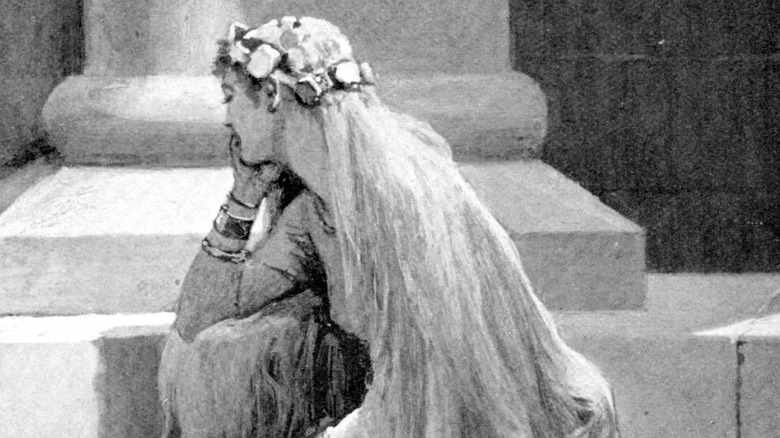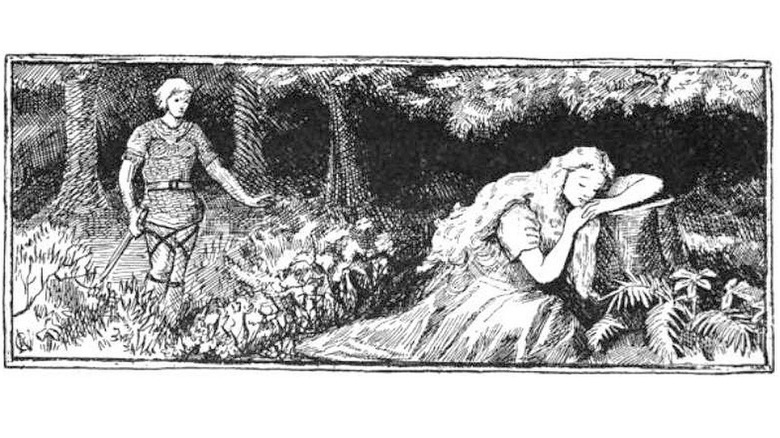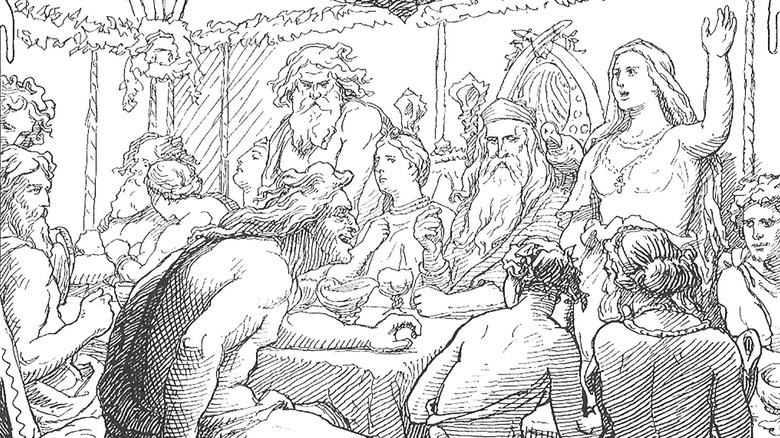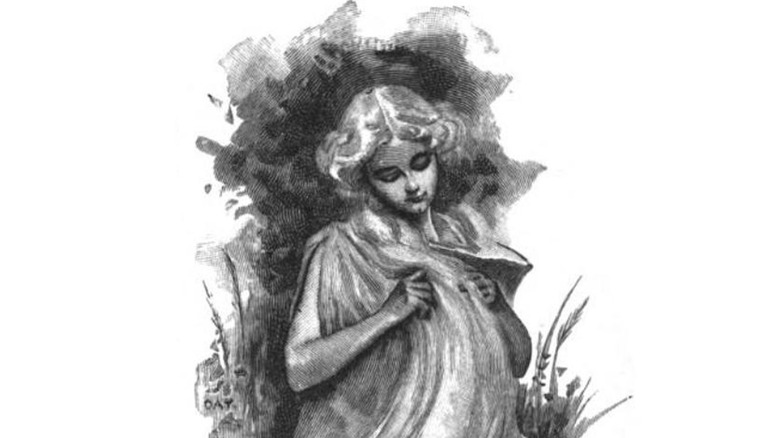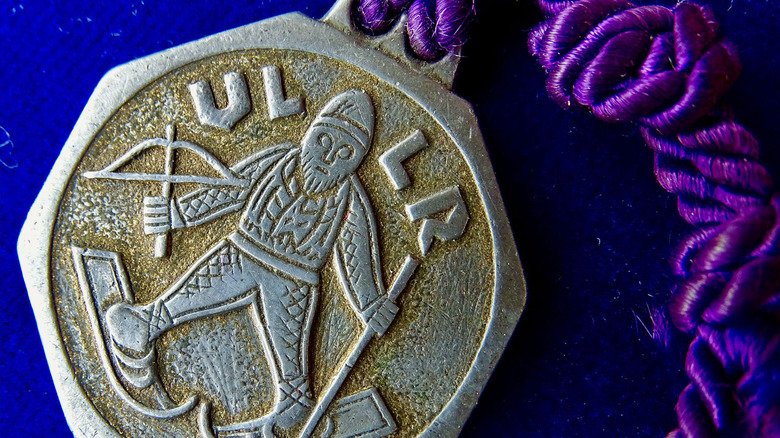The Myth Of Sif Explained
Sif, a goddess known for her long flowing hair, is possibly the most overlooked member of the Norse pantheon. The Prose Edda, the most detailed collection of surviving Norse mythology, hardly mentions her, and artwork of her frequently doesn't even show her face. And yet, despite being such a mysterious figure now, she was a prominent goddess of the Viking era. World History Encyclopedia explains that scholars believe Sif's golden hair was symbolic of golden wheat fields at harvest time, which has led to some debate over whether or not she was also a fertility goddess. This would fit with many other harvest goddesses in the ancient world, but so little is known about Sif that it's difficult to be certain.
As Ancient Origins notes, Sif was the wife of Thor, the god of thunder and the most famous of the Norse gods. All the same, even with Thor's ongoing popularity, Sif appears to have been largely forgotten. Seemingly, at least in the stories which still exist, Sif's role was mostly just as Thor's wife. Her presence hints at much older stories though, and her marriage to Thor hints at an ancient symbolic union between sky and earth. She's also depicted as a prophetess, able to see more than others around her, and a helper of those in difficult times. While modern knowledge of Sif is mostly pieced together from fragments, there are hints that she has a much more interesting past that has since been lost to time.
Sif's mysterious heritage
One aspect of Sif that is lost to time is her family background. While many mythological gods are shown to have families and ancestors, there seems to be no information about Sif's parentage. The Prose Edda even states this explicitly. Its author, Snorri Sturluson, mentions in the foreword to the book that, "none can tell the geneaology of Sif." This seems to suggest that Sif is a very old goddess, dating back to long before the Eddas were written down. Whatever her backstory once was, it's long since been forgotten.
The Prose Edda also lists the names of several of Sif's children, most of whom are never mentioned again. This hints not only at a long history but also at a wealth of lost stories. In a way, this is not too surprising. As a paper in Oral Tradition discusses, written works like the Eddas are the remains of the Norse oral tradition. It's likely that much of this never made it into the written word. Additionally, only one of Sif's children is known to also be Thor's. As World History Encyclopedia explains, Thrud, possibly a Valkyrie, was the daughter of Thor and Sif. Sif's son, Ullr, on the other hand, was not Thor's child. The father of Ullr is never actually named in any surviving stories. Like Sif's ancestors, the identity of the father (or fathers) of her other children remains a mystery.
Sif in modern pop culture
In the modern world, Sif is mostly known from her Marvel Comics character. Her debut appearance was as a supporting character, alongside Thor, in the 1952 comic Journey into Mystery #102 (via SyFy). More recently, she's appeared in the Marvel Cinematic Universe, where she's played by Jaimie Alexander. The comic book version of Sif is, in many ways, quite unlike her mythological counterpart. Where the Sif of legend was most known for her long golden hair, comic Sif has dark hair, and she has a far more warlike personality. Marvel did retain one aspect of Sif's original characterization, however. In the comic books, if not in the movies, Sif is frequently one of Thor's love interests.
A version of Sif has also appeared in a trilogy of books by Rick Riordan, "Magnus Chase and the Gods of Asgard." The Sif in these books is seemingly based more closely on the Norse legends, being married to Thor, having golden hair, and occasionally referencing stories from the Prose Edda. That said, the MCU version of Sif does occasionally reference the mythology too. In the Disney+ series "Loki," Sif makes a cameo appearance in a scene that references some time in the past when Loki cut off Sif's hair. As The Mary Sue explains, this is more than just a throwaway line. The story of Loki cutting Sif's hair is taken directly from Norse mythology. In fact, it's arguably one of the most important Norse legends.
Loki cuts Sif's hair
The Prose Edda tells the tale of Loki's wager with the dwarves, which begins with Loki playing a rather cruel prank and cutting off all of Sif's hair. The story doesn't explain how or why but, as a god of mischief, Loki probably doesn't need any reason for the things he does. Thor, furious at Loki's actions, threatens to maim him, and Loki agrees to find a way to replace Sif's hair. For this, he goes to a group of dwarves known as Ivald's Sons.
Charmed by Loki's silver tongue, the dwarves agree to create a magical hairpiece for Sif. A story book, "The Children of Odin," mentions how Sif's replacement hair is made from a bar of pure gold, hammered into fine silken threads. Prompted by Loki's flattery, the dwarves carefully hammer the gold into fine strands, until the new hair is "as bright as sunlight" and "so light that a bird might not feel its weight." When Sif wears her replacement hair, it even appears as if it's growing naturally from her head.
The reason why this story is so important in Norse mythology, though, is that it's also the origin story of several magical items that the gods are known for. As well as Sif's radiant hair, this tale also sees the dwarves create Odin's unstoppable spear Gungnir and Thor's famous hammer Mjolnir. In an odd turn of events, Loki's mischief ends up giving the other gods their famous weapons.
Accusations of adultery
She's always mentioned as Thor's wife, but a couple of places in the Eddic stories see Sif accused of adultery. World History Encyclopedia explains how a character named Harbardr (who is secretly Odin in disguise) appears in a story from the Poetic Edda, where he repeatedly insults Thor. One of his insults is to tell Thor that, even as they're speaking, Sif is at home with a lover.
Another accusation happens in the Lokasenna, a comedic poem in which Loki throws taunts at the gods in a battle of insults. When it comes to Sif's turn, she offers him some mead, asking him not to find fault with her because she's innocent of any wrongdoing. Sif is not spared from Loki's insults however, and he responds by stating that they'd slept together. While this fits with his other insults to the gods, many of which are accusations of infidelity, some scholars have wondered if perhaps Loki was telling the truth in this case. In her translation of the Poetic Edda, Carolyne Larrington notes that it's never explained how Loki cut off Sif's hair. This might explain how the two were alone together and how Loki was able to catch Sif off-guard to cut off her hair. With this in mind, it seems rather suspect that Sif tries to ply Loki with a drink, perhaps in hopes he won't give away anything about her.
Sif and marriage
Marriage is one thing that Sif has a deep connection with in Norse culture, likely because of her role as the wife of Norse mythology's most famous god. "Zoega's Old Icelandic Dictionary" includes the word "sifjar," which it says can refer to either marriage or adultery. If this word is derived from the name of Sif, as it appears to be, it's seemingly an allusion to her roles in the Eddic stories, both for being married to Thor and as an accused adulterer.
Sif's marriage with Thor seems to have some connection to ideals of marriage during the Viking era too, specifically in that Norse marriages were quite egalitarian. The Poetic Edda carries this idea in a couple of places where Thor is referred to as "Sif's husband" and is shown performing household duties. As Scandinavia Facts explains, married Viking couples typically shared the domestic duties between them. Viking marriages were arranged and were often seen as contracts that would join two families together. All the same, the women in Viking marriages still held many rights, including the ability to divorce their husbands if they were unhappy with their situation. Viking women were not usually forced into marriage. On the occasions that they were, it would usually end in divorce or, in more extreme cases, in the death of the husband.
Sif's lost origins
Any stories that could tell who Sif truly was and where she came from are, sadly, long lost. This is part of what makes Sif's exact status in Norse society something of a puzzle. As World History Encyclopedia mentions, while some scholars argue that Sif was a fertility goddess, she had no cult following like the other Norse fertility goddesses, Freyja and Frigg. There's also very little about what her personality was, with only one surviving story being dedicated to her -– and that story is mostly about Loki.
One possibility is that Sif was originally a deity imported from another culture. This may sound far fetched, but similar things happened elsewhere in the ancient world. One prominent example is the Greek goddess Aphrodite who, as Overly Sarcastic Productions explains, was originally the Mesopotamian goddess Ishtar. The fact that Sif may have undergone a similar transformation is hinted at by Snorri Sturluson in the foreword to the Prose Edda. He briefly mentions that, before she married Thor, Sif was a prophetess named Sibyl. This could possibly be a reference to the Sybils in Greek mythology. An illuminated manuscript discussed by the British Library tells that the Sibyls were a group of 10 female oracles who could be found at sacred sites around the Mediterranean sea. They were famous for their prophecies which, among other things, predicted the Trojan War. Among them, the Delphic Sibyl was, like Sif, known for her beauty and admirers (via the Vatican Museum).
A goddess of the harvest?
A big part of the debate over whether or not Sif was a fertility goddess, as World History Encyclopedia explains, is the association between her golden hair and wheat fields. There's even some debate about this association, however, with some scholars arguing that this could have been an embellishment added by Snorri Sturluson when he wrote the Prose Edda. One fragment of evidence for this is the fact that there's a type of moss that is known as haddr Sifjar in Old Norse, a name that translates as "Sif's hair," seeming to suggest that wheat wasn't her strongest association.
If Sif's hair really was associated with wheat fields, this would make her a similar figure to goddesses from other ancient pantheons, like the Greek goddess Demeter. As Theoi explains, Demeter was a goddess of agriculture, grain, and bread. This linked her to the fertility of the earth and therefore to fertility more generally. This association would certainly have made Sif an important deity in Viking culture, because their society was largely agricultural. Farming was just as important to Vikings as to any other culture in the ancient world and, as the Ribe Viking Center notes, several crops were grown in ancient Scandinavia, including cereals. One of the most important was barley, used to make porridge, bread, and beer, and ripe barley is also notable for its long golden hair.
Sky god, Earth goddess
If Sif truly was associated with fields of billowing golden crops, it makes her marriage to Thor carry some deep symbolism along with it. It also links to the interesting fact that Thor, a warrior and god of thunder and the mightiest and most short-tempered of the Norse pantheon, was also seen as a god of agriculture. As World History Encyclopedia notes, as well as thunder and lightning, Thor was linked with the rain and fair weather, which would allow crops to grow. This seems at odds with his warlike personality and the fact that many of his tales involve battling giants and monsters. However, it makes a lot more sense if these traits are associated with his wife.
As World History Encyclopedia also explains, this makes the marriage between Thor, a sky god, and Sif, an earth goddess, a representation of divine fertility. It should be stressed though, that this is an interpretation rather than a known fact of Norse culture. From the perspective of an ancient farmer, this would symbolize the way rains fertilize the soil, allowing crops to grow. Similar associations can be seen in other ancient religions too. In Greek mythology, as Britannica notes, Zeus is similarly linked with Demeter. This mirrors the idea of a sky god associated with storms and an earth goddess responsible for the harvest.
The son of Sif
Sif's son, Ullr, is an interesting figure who, much like Sif, has an uncertain history. So little is known about him that, as World History Encyclopedia explains, it's difficult to say anything conclusive about him. All the same, Ullr is memorable for his appearance –- he's usually shown wielding a bow and arrow and wearing a pair of skis. This suggests an association with hunting and the winter, which seems to complement Sif's association with late summertime and the harvest. In winter, with fewer crops to eat, ancient societies would have relied more heavily on hunting for food, after all.
One of the oldest surviving sources of Norse mythology is the Poetic Edda, but even this only mentions Ullr a handful of times. Translations of the Edda note that the stories it contains seem to allude to other myths that have since been lost. Unfortunately, this means that any hints they may have contained about Sif's history are lost with them. The Prose Edda doesn't elaborate much on Ullr either. It mentions, simply, that he's the stepson of Thor. Who exactly Ullr's father may be has been debated by scholars, but no one has been able to come up with any definitive answer. It's possible that his father was a former husband or lover of Sif, from before she married Thor. Alternatively, considering the references to Sif's adultery in the surviving stories, Ullr may even have been born as the result of an affair.
Sif's legacy
Sif's past is shrouded by time, and there's a lot about her that may never be known. However, her name lives on in several modern-day landmarks. As a paper in Quaternary Science Reviews mentions, a valley in Greenland is named after her. Sif's Valley is a stretch of land flanked by mountains, containing a glacier, and meltwater from Sif's glacier passes through two lakes on its way to the sea. An expedition page from Jeff Shea shows that the valley stretches out for 40 miles and has some breathtaking views.
Sif's name has even been given to places off Earth. The asteroid 4484 Sif is named for her, discovered in 1987, according to NASA JPL. Elsewhere in the Solar System, Britannica mentions the shield volcano Sif Mons on planet Venus. Sif is in good company on Venus, too. As Mental Floss explains, nearly every geographic feature on the surface of Venus is named after a woman, some fictional, some real. Considering Sif's role in Marvel Comics, it seems rather fitting that there are landmarks on other planets named after her.
